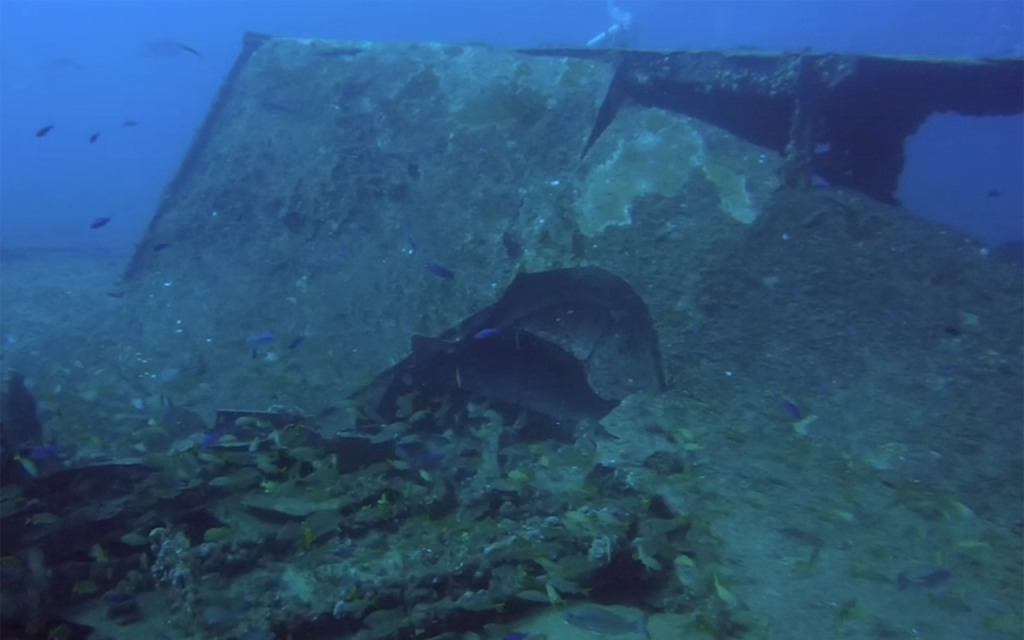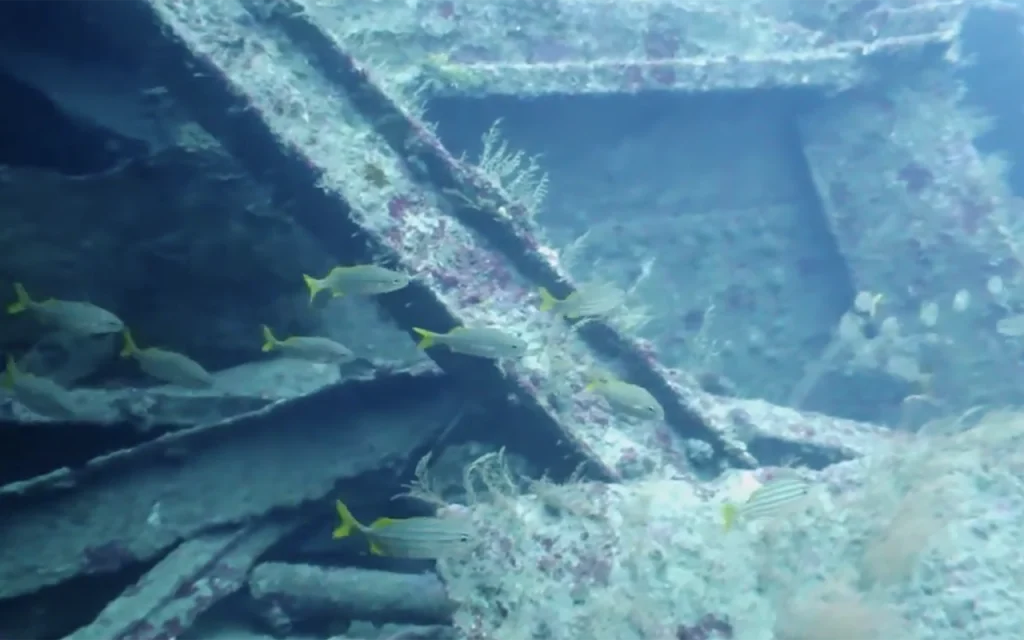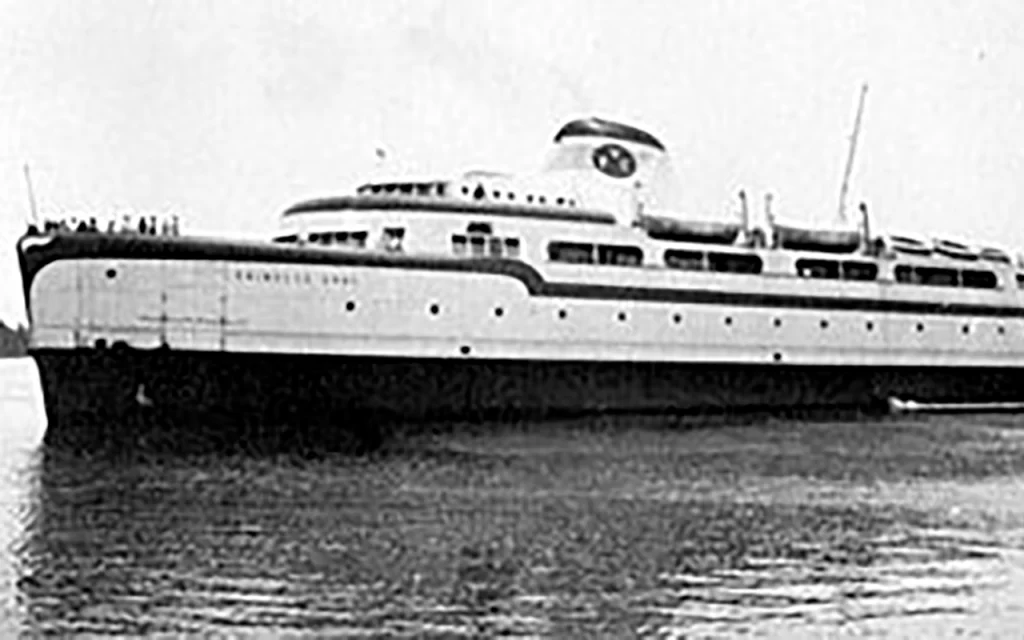Table of Contents

The Princess Anne has quickly established itself as a thriving artificial reef since its sinking in the early 1990s. The abundance and diversity of marine life make it a popular destination for experienced divers and underwater photographers, despite the challenging diving conditions due to depth and currents.
Article at a Glance
- Historical Background: The SS Princess Anne was built in 1897 as a car ferry and served the Chesapeake Bay before being intentionally sunk as an artificial reef in 1993.
- Dimensions: The wreck measures 350 feet long and 42 feet wide, making it one of the largest wrecks in Florida waters.
- Diving Depth: The site is located at a maximum depth of 100 feet, with an average depth of 80 feet, making it suitable only for experienced divers.
- Marine Ecosystem: The wreck has become a thriving artificial reef, attracting diverse marine life, including jacks, barracuda, goliath groupers, and vibrant coral formations.
- Unique Features: Divers can explore various historical elements, including the intact hull, open rooms, staircases, and the separated wheelhouse, which adds to the wreck’s complexity.
- Safety Precautions: Due to its depth and current conditions, diving the Princess Anne requires careful planning, proper training, and adherence to safety protocols for wreck diving.
- Dive Operators: Pura Vida Divers is one of the dive shops that offer trips to the Princess Anne, emphasizing the need for experienced divers due to the challenging conditions at the site.
Shipwreck Location Coordinates and Depth
Depth
Location Coordinates
Coordinates: 26° 47.616′ N, 80° 00.230′ W

What Do Scuba Divers Say About This Ship
Dive Experience
- The Princess Anne is considered one of the best wreck dives in the United States, despite being a relatively recent artificial reef.
- It’s described as the biggest and toughest wreck dive in the Palm Beach area for non-technical divers, mainly due to its depth and often strong currents.
Dive Conditions
- Depth: The wreck sits at a maximum depth of 100 feet (30 meters), with an average depth of 80 feet (24 meters).
- Current: Divers often encounter swift currents, making it suitable only for experienced divers.
Wreck Features
- The 350-foot car ferry sits upright on the seafloor, with its stern at 105 feet and bow at 95 feet.
- A storm separated the wheelhouse from the main ship, increasing the wreck’s complexity and attracting more marine life.
- The hull rises from 100 feet up to 72 feet, creating an excellent multilevel dive profile.
Marine Life
Divers report seeing:
- Schools of jacks and barracuda
- Large parrotfish
- Atlantic spadefish
- Occasional sharks
- Corals covering the wreck structure
Dive Highlights
- Trained wreck divers can explore open rooms, some over 100 feet in length, intact staircases, and other parts of the ship.
- Divers often take photos sitting at the marine head for a unique underwater picture.
- The wreck’s unstable positioning adds to the diving challenge and appeal.
What Kind of Marine Life Can Be Found on The Ship
Fish Species
- Large schools of jacks
- Barracudas
- Atlantic spadefish
- Very large parrotfish
- Occasional sharks
Other Marine Life
- Goliath groupers
- Sea turtles
- Rays
Reef Life
- Corals covering the wreck structure
- Various species of sponges
Noteworthy Observations
- The wreck’s complexity, created when a storm separated the wheelhouse from the main ship, has increased its appeal to marine life.
- Dense schools of tropical fish are not uncommon around the wreck.
- The site is known for attracting large fish species, likely due to its size and location.
Environmental Factors
- The wreck is nestled near a beautiful reef system, which contributes to the diversity of marine life in the area.
- Its depth (100 feet maximum) and location off the Palm Beach coast provide an ideal environment for a variety of marine species.
Key Information
| Category | Details |
|---|---|
| Ship Name | SS Princess Anne |
| Type | Car ferry |
| Construction Year | 1897 |
| Dimensions | 350 feet long, 42 feet wide, 3,629 gross tons |
| Historical Significance | Originally served as a ferry across Chesapeake Bay; intentionally sunk as an artificial reef in 1993 |
| Sinking Date | May 23, 1993 |
| Location Coordinates | 26° 47.616′ N, 80° 00.230′ W |
| Maximum Depth | 100 feet (30 meters) |
| Average Depth | 80 feet (24 meters) |
| Marine Life | Jacks, barracuda, large parrotfish, Atlantic spadefish, goliath groupers, sea turtles, and corals |
| Diving Experience | Advanced dive site; suitable for experienced divers only due to depth and currents |
| Notable Features | Intact hull, open rooms, staircases, separated wheelhouse, art deco design elements |
| Dive Shops | 1. Pura Vida Divers Address: 2513 Beach Ct, Riviera Beach, FL 33404 Phone: (561) 840-8750 Website: Pura Vida Divers |
| Safety Considerations | Depth and current challenges, wreck condition, training requirements, and dive planning needed |
What Makes The Princess Anne Wreck a Unique Diving Experience
Historical Significance
- Built in 1897, the Princess Anne was originally a 350-foot car ferry used to transport passengers and vehicles across the Chesapeake Bay.
- It was intentionally sunk in the early 1990s to create an artificial reef off the coast of Palm Beach, Florida.
Wreck Characteristics
- The ship sits upright on the seafloor, with its stern at 105 feet and bow at 95 feet depth.
- It has an excellent multilevel dive profile, with the hull rising from 100 feet up to 72 feet.
- A storm separated the wheelhouse from the main ship, increasing the wreck’s complexity and appeal.
Marine Life
- The wreck attracts diverse marine life, including:
Diving Experience
- Considered one of the best wreck dives in the United States, despite being a relatively recent artificial reef.
- It’s the biggest and most challenging wreck dive in the Palm Beach area for non-technical divers.
- Experienced wreck divers can explore open rooms over 100 feet in length, intact staircases, and other parts of the ship.
Challenges
- The site is less frequented due to its 100-foot depth and often swift currents, making it suitable only for experienced divers.
- The wreck’s unstable positioning adds to the diving challenge and appeal.
How Does The Princess Anne Compare to Other Shipwrecks in Florida
Size and Structure
- At 350 feet long, the Princess Anne is one of the larger wrecks in Florida waters.
- Its size and upright position create an impressive underwater structure, rising from 100 feet to 72 feet below the surface.
Depth and Accessibility
- With a maximum depth of 100 feet, it’s deeper than many popular Florida wrecks.
- The depth and often strong currents make it suitable only for experienced divers, unlike some shallower, more accessible wrecks in the state.
Historical Significance
- While many Florida wrecks are older vessels or accidental sinkings, the Princess Anne was intentionally sunk as an artificial reef in 1993.
- Its history as a car ferry from the Chesapeake Bay adds a unique backstory compared to military vessels or cargo ships often found in Florida waters.
Marine Life
- The wreck has quickly established itself as a thriving artificial reef, attracting diverse marine life including large schools of fish, sharks, and turtles.
- Its complexity, especially after a storm separated the wheelhouse, has increased its appeal to marine life.
Diving Experience
- The Princess Anne is considered one of the best wreck dives in the United States, despite its relatively recent sinking.
- It offers opportunities for multilevel diving and wreck penetration for properly trained divers, features not available on all Florida wrecks.
What is The Full History of This Ship
Construction and Early Years
- Built in 1897 by Sun Shipbuilding & Drydock Co. in Chester, Pennsylvania
- Originally constructed for the Old Dominion Line
- Dimensions: 350 feet long, 42 feet wide, 3,629 gross tons
- Single screw steamship
Design and Modifications
- In 1936, redesigned by Raymond Loewy with a streamlined, art deco-inspired superstructure
- Launched on May 18, 1936 after redesign
- Originally 246 feet long, later lengthened to 335.5 feet in early 1954
- Displacement increased from 1,587 tons to 2,366 tons after lengthening
Service History
- Virginia Ferry Corporation (1936-1964)
- Operated between Little Creek and Kiptopeke Beach across Chesapeake Bay
- Made four round trips daily, each one-way trip taking about two hours
- Delaware River and Bay Authority (1964-1979)
- Renamed “New Jersey”
- Operated between Cape May, NJ and Lewes, DE
- Mascony Transport and Ferry Service (1979-1980s)
- Renamed “Greenport”
- Operated between Fire Island, NY and Block Island, RI
- Failed Casino Conversion (1980s)
- Purchased by investors planning to convert it into a casino ship
- Plan abandoned due to financial and legal issues
- Derelict Years
- Abandoned at a shipyard in Newport, RI
- Sank during a storm while berthed, later raised by Resolve Marine Group
Final Years and Artificial Reef
- Sold for use as an artificial reef
- Renamed back to “Princess Anne”
- Intentionally sunk on May 23, 1993 off the coast of West Palm Beach, Florida
- Now serves as an artificial reef and scuba diving site
Current Status
- Rests at a depth of approximately 100 feet
- Located at coordinates 26° 47.616′ N, 80° 00.230′ W
- Popular dive site known for its size, complexity, and marine life

What Historical Features Can Still Be Identified on The SS Princess Anne Wreck
Structural Elements
- The ship sits upright on the seafloor, allowing divers to observe its overall shape and structure.
- The hull is still intact, rising from 100 feet up to 72 feet below the surface.
- The stern rests at 105 feet depth, while the bow is at 95 feet.
Distinctive Features
- The wheelhouse, which was separated from the main ship during a storm, can be found beside the hull.
- Open rooms, some over 100 feet in length, are still accessible to trained wreck divers.
- Intact staircases remain within the wreck structure.
Car Ferry Elements
- As a former car ferry, divers may be able to identify features related to its original purpose, such as vehicle loading areas or passenger spaces.
Art Deco Design
- The Princess Anne was redesigned in 1936 by Raymond Loewy with a streamlined, art deco-inspired superstructure. Some elements of this design may still be visible.
Size and Scale
- At 350 feet long and 58 feet wide, the sheer size of the wreck is a testament to its history as a car ferry.
Marine Head
- Divers often take photos sitting at the marine head, suggesting this feature is still identifiable.
What Safety Measures Are in Place for Divers Visiting the SS Princess Anne
- Depth and Experience Requirements:
- The wreck sits at a maximum depth of 100-110 feet, with an average depth of 80 feet.
- It is considered an advanced dive site suitable only for experienced divers due to the depth and often strong currents4.
- Wreck Condition:
- The wreck is in a state of collapse and has been described as resembling a “huge pancake”.
- Penetration of the wreck is considered dangerous, as several divers have died inside its interior in the past.
- Current Safety Practices:
- Due to the wreck’s unstable positioning, penetration is now generally allowed, as the remaining spaces are not large enough to get lost in.
- However, divers should still exercise extreme caution and proper wreck diving techniques.
- Dive Planning:
- The site requires careful dive planning due to its depth and current conditions.
- Multilevel dive profiles are possible, as the hull rises from 100 feet up to 72 feet4.
- Training and Equipment:
- Only properly trained wreck divers should explore the interior spaces4.
- Appropriate equipment for deep diving and potentially challenging conditions is necessary.
- Dive Operator Oversight:
- Reputable dive operators in the area are likely to enforce strict safety protocols and experience requirements for this site.
- Environmental Awareness:
- Divers should be mindful of the marine life and avoid disturbing the wreck structure or ecosystem.
Dive Shops That Provide Diving Trips to This Shipwreck
- Pura Vida Divers
- Address: 2513 Beach Ct, Riviera Beach, FL 33404
- Phone: (561) 840-8750
- Website: http://www.puravidadivers.com





